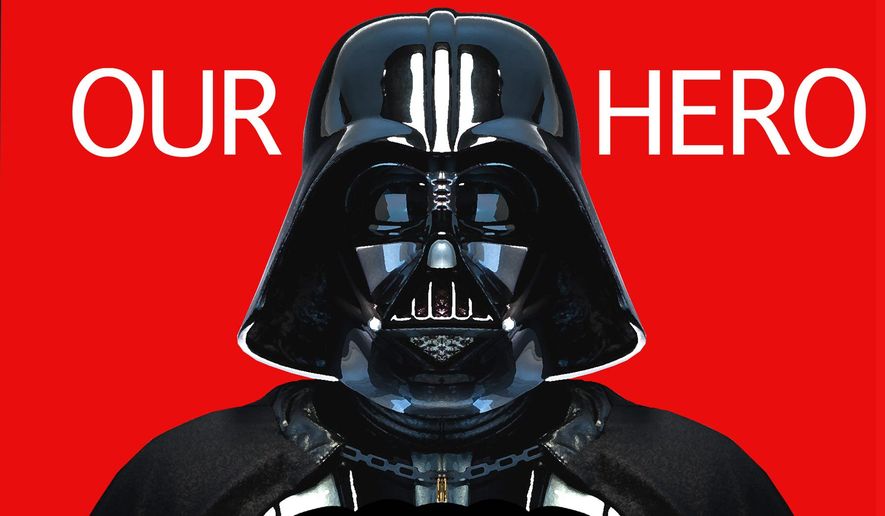OPINION:
On May 25, 1977, the original “Star Wars” movie, “A New Hope,” made its debut. It immediately had an impact that is hard to measure, especially on the generation that would, unfortunately, be called “X,” itself a seemingly sci-fi moniker.
Watching that film and the subsequent two sequels, there was no question whom one would root for. Everyone wanted the forces of the Republic to win, cast as science fiction versions of the American revolutionaries. The dark side, represented best by Darth Vader, was no British officer serving George the III, but a minion of the likes of Hitler or Stalin.
The Force has a good side and an evil side. The dark side represents violence, torture, repression, death — evil. The light side is attracted to order based on morality, ethics, courage and justice. The dark side is attracted to order based on power, treachery and greed.
It is, therefore, astounding to witness the rise in popularity of the dark side among the makers of the “Star Wars” movies and merchandising offshoots. There is a reason that the dark side’s foot soldiers are called “storm troopers,” and that young Darth Vader commits mass murder of children in Episode 3. This is a disturbing trend whose roots run far deeper than movie criticism. Now is the right time for consideration since on Dec. 14, “The Last Jedi” will hit the silver screens, arguably the most anticipated movie in years.
The effect on children is worth considering. We have Disney stores that give equal time to toys and costumes of the dark side; we have video game companies like Electronic Arts whose expected blockbuster game, Star Wars Battlefront II, forces players to take the role of a dark side champion, and a host of department stores that promote equally, if not more partiality given to the evil side, toys and games that enhance the “coolness” of Vader and the storm troopers.
As a father and a “Star Wars” fan who has watched this trend over time, the appropriate reaction can only be a reprise of the famous phrase, uttered by Obi-Wan Kenobi: “I felt a great disturbance in the Force, as if millions of voices suddenly cried out in terror and were suddenly silenced.” It is not something that can be accurately quantified, not in dollars and cents, not in psychological studies. The very fact that any sane person could venerate Darth Vader (before he recants at death), Emperor Palpatine (who gives Caligula a run for his money), or Grand Moff Tarkin (who kills every man, woman and child on an entire planet, regardless of the brilliant performance by Peter Cushing,), is beyond comprehension.
The primary cause of all this is an attempt by the left to force moral relativism down the throats of every American, combined with a dogma called Red Puritanism, in which there are no absolute goods except for the laundry list they have created: multiculturalism, tolerance, atheism, socialist realism, skepticism, activist science, anti-Western ideology (extra piety points for being anti-American) and collective white guilt. There are no immutable goals except for those prescribed by their dogma: ending white privilege, destruction of conservatism, the cult of victimization, a reduction of American military power, and the glorification of anything that shocks.
One can anticipate four criticisms of this analysis. The first is that I am overreacting to a pop culture science fiction movie. Americans in this camp should realize the power of epics, storytelling, legends, myths and language. “Star Wars” changed all of this from 1977 onward and continues today with the release of the newest film.
Second is that only a political scientist or historian would read so deeply into a movie. Perhaps, but perhaps not. The “Star Wars” franchise has millions of followers, generates billions of dollars, and consumes untold hours of conversations and, dare one say, heated arguments. It has the lasting power of a story like “The Lord of the Rings” upon the Western, especially American, psyche. It is debated and discussed more than any other fictional story among large sectors of the population, perhaps more than any current debate or issue in politics today.
Third is the idea that moralizing against “Star Wars” is antithetical to free choice because no one is forced to root for Team Vader. This is reasonable if you embrace the relativistic argument that one can be as easily attracted to Nazi Germany, Soviet Russia or militarist Japan as to America in World War II or the Cold War. Only as a historical parallel can this argument make sense, but it falls under its own intellectual weight.
Finally, one can argue over which ideas filmmaker George Lucas is attempting to promote. Whatever his politics (reportedly anti-Nixon, anti-Republican and anti-conservative), they are not as relevant as the impact of the films’ cultural phenomena.
One does not need to lapse into hysteria to raise these concerns, nor is there any solution that could or should be mandated by government or the entertainment industry. However, that should not stop those who prefer the virtues of the Force to the dark side from asking Americans to reflect on the effects of their silver screen infatuation.
• Lamont Colucci is associate professor of politics at Ripon College and author of “The National Security Doctrines of the American Presidency: How they Shape our Present and Future” (Praeger, 2012).




Please read our comment policy before commenting.